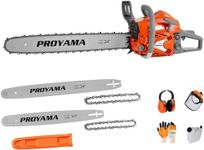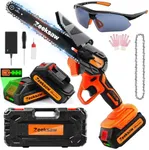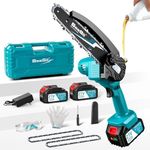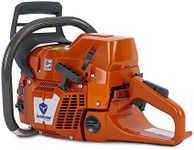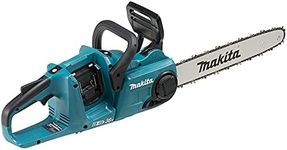Buying Guide for the Best Chainsaws
Choosing the right chainsaw can make your cutting tasks safer, easier, and more efficient. Whether you need it for occasional yard work, regular firewood cutting, or heavy-duty tree felling, understanding the main features will help you find a chainsaw that matches your needs and experience level. Focus on the type of work you plan to do, your comfort with handling power tools, and the environment where you'll be using the chainsaw.Power SourceChainsaws can be powered by gasoline, electricity (corded), or batteries (cordless). Gasoline chainsaws are typically the most powerful and are best for heavy-duty tasks and remote locations, but they are heavier, noisier, and require more maintenance. Corded electric chainsaws are lighter and quieter, making them suitable for light to medium tasks near a power outlet, but their range is limited by the cord. Battery-powered chainsaws offer portability and low noise, ideal for light to moderate work, but their runtime is limited by battery capacity. Consider the type and frequency of your tasks to decide which power source fits your needs best.
Bar LengthThe bar length is the distance from the tip of the chain to where it enters the housing, and it determines the maximum diameter of wood the chainsaw can cut in a single pass. Shorter bars (10-14 inches) are easier to handle and safer for beginners or for pruning and light cutting. Medium bars (16-18 inches) are versatile for most home and property maintenance. Longer bars (20 inches and above) are suited for large trees and heavy-duty work but require more skill and strength to operate safely. Choose a bar length that matches the size of wood you'll be cutting most often and your comfort with handling the tool.
Engine or Motor PowerFor gas chainsaws, power is measured in cubic centimeters (cc), while electric and battery models use amps or volts. Higher power means the chainsaw can handle tougher, thicker wood and cut faster, but it also adds weight and can be harder to control. Light-duty saws (under 35cc or under 10 amps/20 volts) are good for pruning and small branches. Medium-duty (35-50cc or 10-15 amps/36-40 volts) can handle most firewood and storm cleanup. Heavy-duty (over 50cc or 15+ amps/60+ volts) are for large trees and frequent use. Match the power to the toughest job you expect to tackle, but don’t overbuy if you only need it for light work.
WeightThe weight of a chainsaw affects how long you can use it comfortably and how easily you can control it. Lighter chainsaws (under 10 pounds) are easier to maneuver and less tiring, making them ideal for beginners or for overhead work. Heavier models (over 12 pounds) may be necessary for more powerful cutting but can cause fatigue faster. Consider your physical strength and the duration of your typical tasks when choosing the right weight.
Safety FeaturesKey safety features include chain brakes, low-kickback chains, hand guards, and anti-vibration systems. Chain brakes stop the chain quickly in case of kickback, reducing injury risk. Low-kickback chains and hand guards add extra protection, while anti-vibration systems make the saw more comfortable to use for longer periods. If you are new to chainsaws or value extra safety, prioritize models with these features.
Ease of MaintenanceChainsaws require regular maintenance, such as chain tensioning, oiling, and cleaning. Some models offer tool-free chain tensioning and easy-access air filters, making upkeep simpler and faster. If you prefer less hassle or are new to chainsaw maintenance, look for features that make routine care straightforward.
